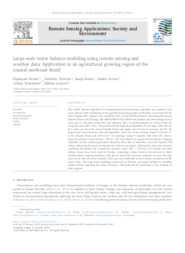Large-scale water balance modeling using remote sensing and weather data: Application in an agricultural growing region of the coastal northeast Brazil.
Large-scale water balance modeling using remote sensing and weather data: Application in an agricultural growing region of the coastal northeast Brazil.
Autoria: FARIAS, F.; TEIXEIRA, A. H. de C.; SOUSA, I.; LEIVAS, J. F.; TAKEMURA, C. M.; GARCON, E. A. M.
Resumo: ABSTRACT: The SAFER (Simple Algorithm for Evapotranspiration Retrieving) algorithm was applied to test water balance (WB) monitoring in the agricultural growing region of SEALBA, an acronym for the states Sergipe (SE), Alagoas (AL), and Bahia (BA), coastal Northeast Brazil, classifying the biomes Atlantic Forest and Caatinga. The MODIS MOD13Q1 reflectance product and meteorological data were used to calculate actual (ET) and reference (ET0 ) evapotranspiration at 16-day timescale along the years 2007?2021. The period with the highest precipitation (P) is in May, when the 16- day values are above 90 mm in Atlantic Forest and higher than 70 mm in Caatinga. For ET, the largest rates occur between July and September, when the 16-day average surpass 2.70 mm d −1 in the Atlantic Forest and 2.90 mm d −1 in Caatinga. Larger P together with lower ET, concentrates the positive water balance - WB (P ? ET) from March to August in both biomes, bringing suitability for the rainfed agriculture. However, from July to December occur the negative WB values, indicating the need of irrigation for critical crop stages. Inferring the root-zone moisture conditions throughout the evaporative fraction values (ETf = ET/ET0 ) it is noticed that their highest values occur from April to October, evidencing a delay between the moment in which rainfall attend evapotranspiration with that in which the root-zone moisture recovers the optimum levels after the driest periods, what was also confirmed by the Pearson correlation coefficient values. The large-scale modelling carried out in SEALBA, presented viability to subsidize public policies regarding the water resources, with potential for replication of the methods in other regions.
Ano de publicação: 2023
Tipo de publicação: Artigo de periódico
Unidade: Embrapa Territorial
Palavras-chave: Evapotranspiration, Precipitation, SAFER, SEALBA, Water resources
Observações
1 - Por padrão são exibidas publicações dos últimos 20 anos. Para encontrar publicações mais antigas, configure o filtro ano de publicação, colocando o ano a partir do qual você deseja encontrar publicações. O filtro está na coluna da esquerda na busca acima.
2 - Para ler algumas publicações da Embrapa (apenas as que estão em formato ePub), é necessário ter, no celular ou computador, um desses softwares gratuitos. Sistemas Android: Google Play Livros; IOS: iBooks; Windows e Linux: software Calibre.
Acesse outras publicações
Acesse a Base de Dados da Pesquisa Agropecuária (BDPA) para consultar o acervo completo das bibliotecas da Embrapa.

